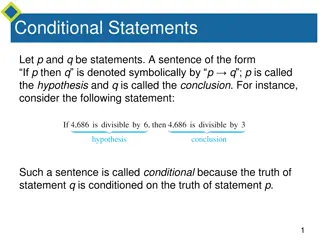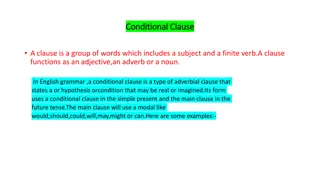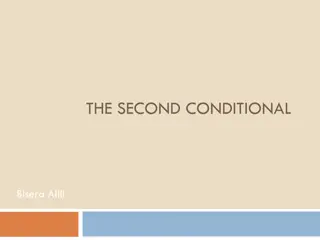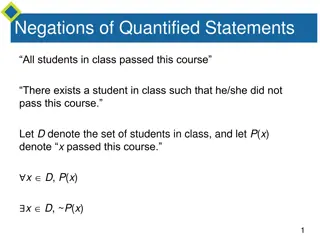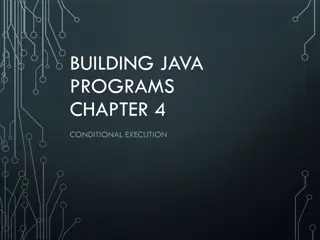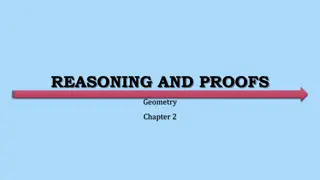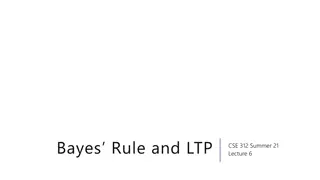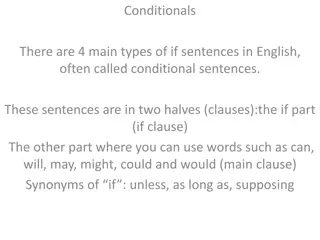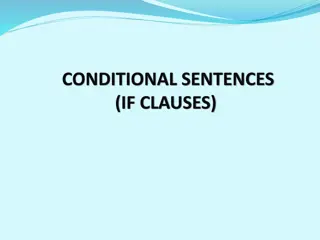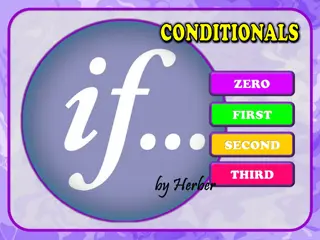Understanding Conditional Execution in Programming
Conditional execution, such as the if statement, allows executing specific blocks of code based on certain conditions being met. This concept is fundamental in programming and is demonstrated through examples like if, if/else, relational expressions, and nested if/else constructs. The incorrect usage of if statements and nested if/else chains are highlighted to understand common mistakes. By grasping these concepts, programmers can control the flow of their code efficiently.
Download Presentation

Please find below an Image/Link to download the presentation.
The content on the website is provided AS IS for your information and personal use only. It may not be sold, licensed, or shared on other websites without obtaining consent from the author. Download presentation by click this link. If you encounter any issues during the download, it is possible that the publisher has removed the file from their server.
E N D
Presentation Transcript
Conditional Execution CSCI 161 Introduction to Programming I William Killian
The if statement Executes a block of statements only if a test is true if (test) { statement; ... statement; } Example: double gpa = console.nextDouble(); if (gpa >= 2.0) { System.out.println("Application accepted."); }
The if/else statement Executes one block if a test is true, another if false if (test) { statement(s); } else { statement(s); } Example: double gpa = console.nextDouble(); if (gpa >= 2.0) { System.out.println("Welcome to Mars University!"); } else { System.out.println("Application denied."); }
Relational expressions if statements and for loops both use logical tests. for (int i = 1; i <= 10; i++) { ... if (i <= 10) { ... oThese are boolean expressions (more on these later) Tests use relational operators: Operator == != < > <= >= Meaning Example 1 + 1 == 2 3.2 != 2.5 10 < 5 10 > 5 126 <= 100 false 5.0 >= 5.0 Value true true false true equals does not equal less than greater than less than or equal to greater than or equal to true
Misuse of if What's wrong with the following code? Scanner console = new Scanner(System.in); System.out.print("What percentage did you earn? "); int percent = console.nextInt(); if (percent >= 90) { System.out.println("You got an A!"); } if (percent >= 80) { System.out.println("You got a B!"); } if (percent >= 70) { System.out.println("You got a C!"); } if (percent >= 60) { System.out.println("You got a D!"); } if (percent < 60) { System.out.println("You got an F!"); } ...
Nested if/else Chooses between outcomes using many tests if (test) { statement(s); } else if (test) { statement(s); } else { statement(s); } Example: if (x > 0) { System.out.println("Positive"); } else if (x < 0) { System.out.println("Negative"); } else { System.out.println("Zero"); }
Nested if/else/if o If it ends with else, exactly one path must be taken. o If it ends with if, the code might not execute any path. if (test) { statement(s); } else if (test) { statement(s); } else if (test) { statement(s); } Example: if (place == 1) { System.out.println("Gold medal!"); } else if (place == 2) { System.out.println("Silver medal!"); } else if (place == 3) { System.out.println("Bronze medal."); }
Nested if structures exactly 1 path (mutually exclusive) 0 or 1 path (mutually exclusive) if (test) { statement(s); } else if (test) { statement(s); } else { statement(s); } if (test) { statement(s); } else if (test) { statement(s); } else if (test) { statement(s); } 0, 1, or many paths (independent tests; not exclusive) if (test) { statement(s); } if (test) { statement(s); } if (test) { statement(s); }
Which nested if/else? (1) if/if/if (2) nested if/else (3) nested if/else/if o Whether a user is lower, middle, or upper-class based on income. (2) nested if / else if / else o Whether you made the dean's list (GPA 3.8) or honor roll [3.5, 3.8). (3) nested if / else if o Whether a number is divisible by 2, 3, and/or 5. (1) sequential if / if / if o Computing a grade of A, B, C, D, or F based on a percentage. (2) nested if / else if / else if / else if / else
Nested if/else question BMI Weight class underweight normal overweight obese Formula for body mass index (BMI): weight BMI below 18.5 18.5 - 24.9 25.0 - 29.9 30.0 and up =height 2 703 Write a program that produces output like the following: This program reads data for two people and computes their body mass index (BMI). Enter next person's information: height (in inches)? 70.0 weight (in pounds)? 194.25 Enter next person's information: height (in inches)? 62.5 weight (in pounds)? 130.5 Person 1 BMI = 27.868928571428572 overweight Person 2 BMI = 23.485824 normal Difference = 4.3831045714285715
Nested if/else answer // This program computes two people's body mass index (BMI) and // compares them. The code uses Scanner for input, and parameters/returns. import java.util.*; // so that I can use Scanner public class BMI { public static void main(String[] args) { printIntro(); Scanner console = new Scanner(System.in); double bmi1 = readInfoAndComputeBmi(console); double bmi2 = readInfoAndComputeBmi(console); // report overall results reportResult(1, bmi1); reportResult(2, bmi2); System.out.println("Difference = " + Math.abs(bmi1 - bmi2)); } // prints a welcome message explaining the program public static void printIntro() { System.out.println("This program reads data for two people and"); System.out.println("computes their body mass index (BMI)."); System.out.println(); } ...
Nested if/else, cont'd. // reads information for one person, computes their BMI, and returns it public static double readInfoAndComputeBmi(Scanner console) { System.out.println("Enter next person's information:"); System.out.print("height (in inches)? "); double height = console.nextDouble(); System.out.print("weight (in pounds)? "); double weight = console.nextDouble(); System.out.println(); double bodyMass = computeBmi(height, weight); return bodyMass; } // Computes/returns a person's BMI based on their height and weight. public static double computeBmi(double height, double weight) { return (weight * 703 / (height * height)); } // Outputs information about a person's BMI and weight status. public static void reportResult(int number, double bmi) { System.out.println("Person " + number + " BMI = " + bmi); // Complete... } }
Scanners as parameters If many methods need to read input, declare a Scanner in main and pass it to the other methods as a parameter. public static void main(String[] args) { Scanner console = new Scanner(System.in); int sum = readSum3(console); System.out.println("The sum is " + sum); } // Prompts for 3 numbers and returns their sum. public static int readSum3(Scanner console) { System.out.print("Type 3 numbers: "); int num1 = console.nextInt(); int num2 = console.nextInt(); int num3 = console.nextInt(); return num1 + num2 + num3; } Downside?
Logical operators Tests can be combined using logical operators: Operator && || ! Description and or not Example Result (2 == 3) && (-1 < 5) false (2 == 3) || (-1 < 5) !(2 == 3) true true "Truth tables" for each, used with logical values p and q: p && q true p || q true true true false !p p q p true true false true false false false true false false true false true false false
Evaluating logic expressions Relational operators have lower precedence than math. 5 * 7 >= 3 + 5 * (7 - 1) 5 * 7 >= 3 + 5 * 6 35 >= 3 + 30 35 >= 33 true Relational operators cannot be "chained" as in algebra. 2 <= x <= 10 true <= 10 (assume that x is 15) error! oInstead, combine multiple tests with && or || 2 <= x && x <= 10 true && false false
Logical questions What is the result of each of the following expressions? int x = 42; int y = 17; int z = 25; oy < x && y <= z ox % 2 == y % 2 || x % 2 == z % 2 ox <= y + z && x >= y + z o!(x < y && x < z) o(x + y) % 2 == 0 || !((z - y) % 2 == 0) Exercise Write a program that prompts for information about a person and uses it to decide whether to date them.
Factoring if/else code factoring: Extracting common/redundant code. oCan reduce or eliminate redundancy from if/else code. Example: if (a == 1) { System.out.println(a); x = 3; b = b + x; } else if (a == 2) { System.out.println(a); x = 6; y = y + 10; b = b + x; } else { // a == 3 System.out.println(a); x = 9; b = b + x; } System.out.println(a); x = 3 * a; if (a == 2) { y = y + 10; } b = b + x;
if/else with return // Returns the larger of the two given integers. public static int max(int a, int b) { if (a > b) { return a; } else { return b; } } Methods can return different values using if/else oWhichever path the code enters, it will return that value. oReturning a value causes a method to immediately exit. oAll paths through the code must reach a return statement.
All paths must return public static int max(int a, int b) { if (a > b) { return a; } // Error: why? } The following also does not compile: why? public static int max(int a, int b) { if (a > b) { return a; } else if (b >= a) { return b; } }
if/else, return question Write a method quadrant that accepts a pair of real numbers x and y and returns the quadrant for that point: y+ quadrant 1 quadrant 2 x- x+ quadrant 4 quadrant 3 y- oExample: quadrant(-4.2, 17.3) returns 2 If the point falls directly on either axis, return 0.
if/else, return answer public static int quadrant(double x, double y) { // Determine quadrant! }
Adding many numbers How would you find the sum of all integers from 1-1000? // This may require a lot of typing int sum = 1 + 2 + 3 + 4 + ... ; System.out.println("The sum is " + sum); What if we want the sum from 1 to 1,000,000? Or the sum up to any maximum? oHow can we generalize the above code?
Cumulative sum loop int sum = 0; for (int i = 1; i <= 1000; i++) { sum = sum + i; } System.out.println("The sum is " + sum); cumulative sum: A variable that keeps a sum in progress and is updated repeatedly until summing is finished. oThe sum in the above code is a cumulative sum. oMust be declared outside the loops that update them, so that they will still exist after the loop
Cumulative product This cumulative idea can be used with other operators: int product = 1; for (int i = 1; i <= 20; i++) { product = product * 2; } System.out.println("2 ^ 20 = " + product); oHow would we make the base and exponent adjustable via a power method?
Scanner and cumul. sum We can do a cumulative sum of user input: // Build Scanner object // Get 100 # s from user and sum them
Cumulative sum question Modify the Receipt program from before oPrompt for how many people, and each person's dinner cost. oUse static methods to structure the solution. Example log of execution: How many people ate? 4 Person #1: How much did your dinner cost? 20.00 Person #2: How much did your dinner cost? 15 Person #3: How much did your dinner cost? 30.0 Person #4: How much did your dinner cost? 10.00 Subtotal: $75.0 Tax: $6.0 Tip: $11.25 Total: $92.25
Cumulative sum answer // This program enhances our Receipt program using a cumulative sum. import java.util.*; public class Receipt2 { public static void main(String[] args) { Scanner console = new Scanner(System.in); double subtotal = computeMealSubtotal(console); printResults(subtotal); } // Prompts for number of people and returns total meal subtotal. public static double computeMealSubtotal(Scanner console) { System.out.print("How many people ate? "); int people = console.nextInt(); double subtotal = 0.0;// cumulative sum for (int i = 1; i <= people; i++) { System.out.print("Person #" + i + ": How much did your dinner cost? "); double personCost = console.nextDouble(); subtotal = subtotal + personCost;// add to sum } return subtotal; } ...
Cumulative answer, cont'd. ... // Calculates total owed, assuming 8% tax and 15% tip public static void printResults(double subtotal) { double tax = subtotal * .08; double tip = subtotal * .15; double total = subtotal + tax + tip; System.out.println("Subtotal: $" + subtotal); System.out.println("Tax: $" + tax); System.out.println("Tip: $" + tip); System.out.println("Total: $" + total); } }
if/else, return question Write a method countFactors that returns the number of factors of an integer. ocountFactors(24) returns 8 because 1, 2, 3, 4, 6, 8, 12, and 24 are factors of 24. Solution: // Returns how many factors the given number has. public static int countFactors(int number) { int count = 0; ... return count; }
Type char char : A primitive type representing single characters. oA String is stored internally as an array of char index 0 1 2 3 4 5 String s = "Ali G."; value 'A' 'l' 'i' ' ' 'G' '.' oIt is legal to have variables, parameters, returns of type char surrounded with apostrophes: 'a' or '4' or '\n' or '\'' char letter = 'P'; System.out.println(letter); // P System.out.println(letter + " Diddy"); // P Diddy
The charAt method The chars in a String can be accessed using the charAt method. String food = "cookie"; char firstLetter = food.charAt(0); // 'c' System.out.println(firstLetter + " is for " + food); You can use a for loop to print or examine each character. String major = "CSCI"; for (int i = 0; i < major.length(); i++) { char c = major.charAt(i); System.out.println(c); }
Comparing char values You can compare chars with ==, !=, and other operators: String word = console.next(); char last = word.charAt(word.length() - 1); if (last == 's') { System.out.println(word + " is plural."); } // prints the alphabet for (char c = 'a'; c <= 'z'; c++) { System.out.print(c); }
char vs. int Each char is mapped to an integer value internally oCalled an ASCII value 'A' is 65 'a' is 97 'B' is 66 'b' is 98 ' ' is 32 '*' is 42 oMixing char and int causes automatic conversion to int. 'a' + 10 is 107, 'A' + 'A' is 130 oTo convert an int into the equivalent char, type-cast it. (char) ('a' + 2) is 'c'
char vs. String "h" is a String, but 'h' is a char A String is an object; it contains methods. String s = "h"; s = s.toUpperCase(); // "H" int len = s.length(); // 1 char first = s.charAt(0); // 'H' A char is primitive; you can't call methods on it. char c = 'h'; c = c.toUpperCase(); // ERROR s = s.charAt(0).toUpperCase(); // ERROR o What is s + 1 ? What is c + 1 ? o What is s + s ? What is c + c ?
Formatting text with printf System.out.printf("format string", parameters); A format string can contain placeholders to insert parameters: o%d integer o%f real number o%s string these placeholders are used instead of + concatenation oExample: int x = 3; int y = -17; System.out.printf("x is %d and y is %d!\n", x, y); printf does not drop to the next line unless you write \n
printf width o%Wd o%-Wd o%Wf o... for (int i = 1; i <= 3; i++) { for (int j = 1; j <= 10; j++) { System.out.printf("%4d", (i * j)); } System.out.println(); // to end the line } integer, W characters wide, right-aligned integer, W characters wide, left-aligned real number, W characters wide, right-aligned Output: 1 2 3 4 5 6 7 8 9 10 2 4 6 8 10 12 14 16 18 20 3 6 9 12 15 18 21 24 27 30
printf precision o%.Df o%W.Df real number, W chars wide, D digits after decimal o%-W.Df real number, W wide (left-align), D after decimal real number, rounded to D digits after decimal double gpa = 3.253764; System.out.printf("your GPA is %.1f\n", gpa); System.out.printf("more precisely: %8.3f\n", gpa); Output: your GPA is 3.3 more precisely: 3.254 3 8
printf question Modify our Receipt program to better format its output. oDisplay results in the format below, with $ and 2 digits after . Example log of execution: How many people ate? 4 Person #1: How much did your dinner cost? 20.00 Person #2: How much did your dinner cost? 15 Person #3: How much did your dinner cost? 25.0 Person #4: How much did your dinner cost? 10.00 Subtotal: $70.00 Tax: $5.60 Tip: $10.50 Total: $86.10
printf answer (partial) ... // Calculates total owed, assuming 8% tax and 15% tip public static void results(double subtotal) { double tax = subtotal * .08; double tip = subtotal * .15; double total = subtotal + tax + tip; // System.out.println("Subtotal: $" + subtotal); // System.out.println("Tax: $" + tax); // System.out.println("Tip: $" + tip); // System.out.println("Total: $" + total); System.out.printf(?); ... } }
Comparing strings Relational operators such as < and == fail on objects. Scanner console = new Scanner(System.in); System.out.print("What is your name? "); String name = console.next(); if (name == "Barney") { System.out.println("I love you, you love me,"); System.out.println("We're a happy family!"); } oThis code will compile, but it will not print the song. o== compares objects by references (seen later), so it often gives false even when two Strings have the same letters.
The equals method Objects are compared using a method named equals. Scanner console = new Scanner(System.in); System.out.print("What is your name? "); String name = console.next(); if (name.equals("Barney")) { System.out.println("I love you, you love me,"); System.out.println("We're a happy family!"); } o Technically this is a method that returns a value of type boolean, the type used in logical tests.
String test methods Method equals(str) equalsIgnoreCase(str) Description whether two strings contain the same characters whether two strings contain the same characters, ignoring upper vs. lower case whether one contains other's characters at start startsWith(str) endsWith(str) contains(str) whether one contains other's characters at end whether the given string is found within this one String name = console.next(); if (name.startsWith("Prof")) { System.out.println("When are your office hours?"); } else if (name.equalsIgnoreCase("DIDDY")) { System.out.println("Let's rap!"); }




